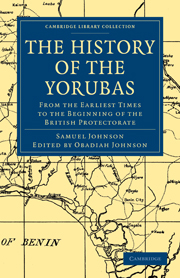3 - A SKETCH OF YORUBA GRAMMAR
Published online by Cambridge University Press: 05 July 2011
Summary
The efforts we have seen made to produce a Yoruba Grammar on the exact lines of an English or Latin Grammar represent in our opinion an honest labour, highly commendable indeed it may be, but totally in the wrong direction, and little calculated to elucidate the genius of the language. On the contrary, they go a long way to obscure it.
The Yoruba belongs to the agglutinated order of speech, not to the inflectional. When therefore particles are used to form cases, etc., it is mere pedantry to talk of declensions.
It is a notorious fact that educated Yorubas find it much easier to read an English book than a Yoruba production—which until recently are mostly translations. With an effort they may plod through it, but they do not enjoy reading it, and sometimes do not even understand it. The main reasons for this are:—
1. The orthography of the language is still very defective.
2. The style in which the books are written. This may simply be described as English ideas in Yoruba words: the result is often obscurity and confusion of thought.
In the “Church Missionary Intelligencer” for March, 1880, a missionary to Japan, who had experienced a similar difficulty, wrote thus:—
“There is great danger, in all use of this language, of thinking that when we have rendered various English words into Japanese we have of necessity expressed the thoughts which the English words convey. Language may correspond to language, but the thoughts to which the language is the vehicle may be as distant as the poles. Our language must be idiomatic or the natives will fail to see the points on which we are endeavouring to lay so much stress.”
- Type
- Chapter
- Information
- The History of the YorubasFrom the Earliest Times to the Beginning of the British Protectorate, pp. xxxiii - lviPublisher: Cambridge University PressPrint publication year: 2010First published in: 1921



